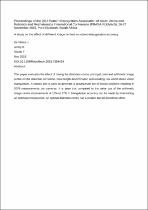 ResearchSpace
ResearchSpace
A study on the effect of different image centres on stereo triangulation accuracy
JavaScript is disabled for your browser. Some features of this site may not work without it.
- ResearchSpace
- →
- Research Publications/Outputs
- →
- Conference Publications
- →
- View Item
| dc.contributor.author |
De Villiers, J

|
|
| dc.contributor.author |
Jermy, R

|
|
| dc.contributor.author |
Nicolls, F

|
|
| dc.date.accessioned | 2016-08-22T11:35:17Z | |
| dc.date.available | 2016-08-22T11:35:17Z | |
| dc.date.issued | 2015-11 | |
| dc.identifier.citation | De Villiers, J. Jermy, R. and Nicolls, F. 2015. A study on the effect of different image centres on stereo triangulation accuracy. In: Proceedings of the 2015 Pattern Recognition Association of South Africa and Robotics and Mechatronics International Conference (PRASA-RobMech), 26-27 November 2015, Port Elizabeth, South Africa | en_US |
| dc.identifier.uri | 10.1109/RoboMech.2015.7359493 | |
| dc.identifier.uri | http://hdl.handle.net/10204/8732 | |
| dc.description | Proceedings of the 2015 Pattern Recognition Association of South Africa and Robotics and Mechatronics International Conference (PRASA-RobMech), 26-27 November 2015, Port Elizabeth, South Africa. | en_US |
| dc.description.abstract | This paper evaluates the effect of mixing the distortion centre, principal point and arithmetic image centre on the distortion correction, focal length determination and resulting real-world stereo vision triangulation. A robotic arm is used to generate a ground truth set of known positions resulting in 2078 measurements per cameras. It is seen that compared to the naive use of the arithmetic image centre improvements of 10% to 27% in triangulation accuracy can be made by determining an optimal principal point. An optimal distortion centre has a smaller but still beneficial effect. | en_US |
| dc.language.iso | en | en_US |
| dc.publisher | IEEE Xplore | en_US |
| dc.relation.ispartofseries | Workflow;16224 | |
| dc.subject | Stereo triangulation accuracy | en_US |
| dc.subject | Image centres | en_US |
| dc.subject | Pattern recognition | en_US |
| dc.subject | Photogrammetry | en_US |
| dc.subject | Camera calibration | en_US |
| dc.subject | Stereo vision | en_US |
| dc.title | A study on the effect of different image centres on stereo triangulation accuracy | en_US |
| dc.type | Conference Presentation | en_US |
| dc.identifier.apacitation | De Villiers, J., Jermy, R., & Nicolls, F. (2015). A study on the effect of different image centres on stereo triangulation accuracy. IEEE Xplore. http://hdl.handle.net/10204/8732 | en_ZA |
| dc.identifier.chicagocitation | De Villiers, J, R Jermy, and F Nicolls. "A study on the effect of different image centres on stereo triangulation accuracy." (2015): http://hdl.handle.net/10204/8732 | en_ZA |
| dc.identifier.vancouvercitation | De Villiers J, Jermy R, Nicolls F, A study on the effect of different image centres on stereo triangulation accuracy; IEEE Xplore; 2015. http://hdl.handle.net/10204/8732 . | en_ZA |
| dc.identifier.ris | TY - Conference Presentation AU - De Villiers, J AU - Jermy, R AU - Nicolls, F AB - This paper evaluates the effect of mixing the distortion centre, principal point and arithmetic image centre on the distortion correction, focal length determination and resulting real-world stereo vision triangulation. A robotic arm is used to generate a ground truth set of known positions resulting in 2078 measurements per cameras. It is seen that compared to the naive use of the arithmetic image centre improvements of 10% to 27% in triangulation accuracy can be made by determining an optimal principal point. An optimal distortion centre has a smaller but still beneficial effect. DA - 2015-11 DB - ResearchSpace DP - CSIR KW - Stereo triangulation accuracy KW - Image centres KW - Pattern recognition KW - Photogrammetry KW - Camera calibration KW - Stereo vision LK - https://researchspace.csir.co.za PY - 2015 T1 - A study on the effect of different image centres on stereo triangulation accuracy TI - A study on the effect of different image centres on stereo triangulation accuracy UR - http://hdl.handle.net/10204/8732 ER - | en_ZA |





